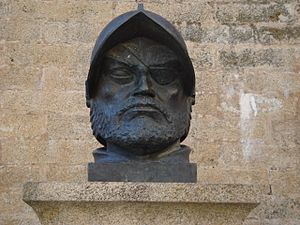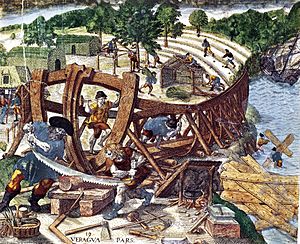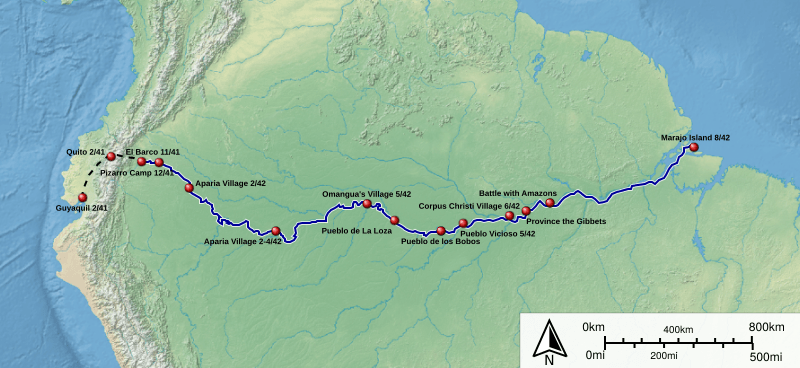Francisco de Orellana facts for kids
Quick facts for kids
Francisco de Orellana
|
|
|---|---|

A bust of Francisco de Orellana with a patch over his left eye
|
|
| Born | 1511 |
| Died | November 1546 (aged 34–35) |
| Nationality | Castilian (Spanish) |
| Occupation | Conquistador |
| Employer | Charles V, Holy Roman Emperor |
| Known for | First known navigation through the length of the Amazon River |
| Spouse(s) | Ana de Ayala |
Francisco de Orellana (born in 1511, died in November 1546) was a Spanish explorer and conquistador. He was the first known European to travel the entire length of the Amazon River. This huge river was even called "Rio de Orellana" for a while! It was later renamed "Amazon" after stories of battles with women warriors from the Tapuyas tribe. Orellana also helped start the city of Guayaquil in what is now Ecuador. Sadly, Orellana died during his second trip to the Amazon.
Contents
Who Was Francisco de Orellana?
Orellana was born in Trujillo, Spain. He was a close friend and possibly a relative of Francisco Pizarro. Pizarro was another famous conquistador who conquered Peru. Orellana traveled to the New World (the Americas) around 1527.
He worked in Nicaragua before joining Pizarro's army in Peru in 1533. Orellana supported Pizarro in a fight against Diego de Almagro in 1538. After Pizarro won, Orellana became governor of a place called La Culata. He also helped rebuild the town of Guayaquil.
Orellana's First Amazon River Journey
In 1540, Gonzalo Pizarro became governor of Quito. His older half-brother, Francisco Pizarro, asked him to find the "Land of Cinnamon" to the east. Orellana was one of Gonzalo Pizarro's main helpers on this trip in 1541.
Gonzalo Pizarro gathered 220 Spanish soldiers and 4,000 native people in Quito. Orellana went to Guayaquil to get more men and horses. Pizarro left Quito in February 1541, just before Orellana arrived with his 23 men and horses. Orellana quickly caught up with the main group in March. But by then, many people had died or left the expedition.
When they reached the Coca River, they built a small boat called the San Pedro. This boat was used to carry sick people and supplies. Gonzalo Pizarro told Orellana to explore the Coca River and come back. But when Orellana's group reached the Napo River, his men wanted to keep going.
On December 26, 1541, Orellana agreed to lead this new journey. He and 50 men went downstream to find food. They couldn't go back against the strong river current. Orellana waited for Pizarro, but Pizarro had already gone back to Quito. Orellana then started building a second boat, the Victoria.
After leaving the Napo River, Orellana continued downstream to the Amazon. His 49 men built a larger ship for river travel. They faced threats from the Omaguas people along the Napo River. On June 3, 1542, they reached the Negro River and finally the main Amazon River.
Around 69°W longitude, Orellana's men fought with the Machiparo natives. They were chased downstream. They passed several rivers and villages. At about 57°W, they entered the land of the Pira-tapuya people.
The name 'Amazon' comes from a battle Orellana had with the Tapuyas tribe. The women of this tribe fought alongside the men. Orellana called the river "the river of the Amazons." He was thinking of the mythical Amazons from ancient Greek stories. This battle with the warrior women happened on June 24, 1542. It was near the Trombetus River, close to where the Madeira River joins the Amazon.
Around 54°W, they stopped for 18 days to fix their boats. Finally, on August 26, 1542, they reached the open sea. They checked their boats to make sure they were safe for the ocean. They sailed along the coast towards Guiana. The two boats got separated but met again at Nueva Cadiz on Cubagua island, off the coast of Venezuela.
The Victoria, with Orellana on board, sailed south around Trinidad. It was stuck in the Gulf of Paria for seven days. It finally reached Cubagua on September 11, 1542. The San Pedro sailed north of Trinidad and arrived at Cubagua on September 9.
Orellana's Second Expedition and Death
Planning the Next Journey
From Cubagua, Orellana decided to go back to Spain. He wanted the king to make him governor of the new lands he had found. He called these lands New Andalusia. After a difficult trip, he first landed in Portugal. The Portuguese king welcomed him and offered him a chance to return to the Amazon under Portugal's flag.
Orellana's discovery caused an international problem. The Treaty of Tordesillas said that most of the Amazon River belonged to Spain. But the river's mouth was in Portuguese territory. Orellana refused the Portuguese offer and went to Valladolid, Spain.
After nine months of talks, King Charles I of Spain made him governor of New Andalusia on February 18, 1544. The plan was for Orellana to explore and settle the Amazon lands. He was to bring at least 300 men and 100 horses. He also had to build two cities: one at the river's mouth and one further inland.
Orellana told exciting stories about his first Amazon journey to the Spanish court. He finally got permission to conquer the areas he had found. He was allowed to explore and settle Nueva Andalucia. He needed at least 200 foot soldiers, 100 horsemen, and materials to build two river boats. He was supposed to build two towns when he reached the Amazon.
Getting ready for the trip was hard. Orellana had debts, and there were Portuguese spies. He also decided to marry a young, poor girl named Ana de Ayala. He planned to take her and her sisters with him. Money was raised by Cosmo de Chaves, Orellana's stepfather. Finally, Orellana's creditors let him sail. On May 11, 1545, Orellana secretly sailed out of Sanlucar with four ships.
The Final Expedition
On May 11, 1545, Orellana left Spain with four ships. He had supplies to build two river boats, about 300 men, at least 24 horses, and his young wife. Before leaving land, he took cattle, pigs, and chickens from a farm. At sea, he stopped another ship and took its supplies.
He reached Tenerife and stayed there for three months to fix his ships. Then he sailed to the Cape Verde Islands. There, an illness killed 98 of his men, and 50 or 60 others left. Because of these losses, he left one of his ships behind. He sailed again around mid-November. The journey was tough. One ship got separated and was never seen again. On that ship were 77 men, 11 horses, and supplies for one river boat. He lost several anchors and had to use cannons instead.
He reached the coast of Brazil. He sailed until he found fresh water in the sea, which he guessed came from the Amazon. He landed on December 20, 1545, with two ships, 11 thin horses, and about 100 men. The native people were friendly, and there was plenty of food. His men wanted to rest and build a river boat. But Orellana decided to keep going to find the main Amazon branch.
After sailing more than 300 miles, he made camp and started building a river boat. This took from January to March. The natives were not friendly, and there was little food. They had to eat all their dogs and horses. Fifty-seven men died. He sent the new boat to find food, but it came back empty. Several men on it had died from hunger or wounds.
Orellana continued with his remaining ship and the river boat. After traveling 75 miles southeast, the ship crashed on a river bank. Orellana went on with the boat, leaving many men at the shipwreck camp. After almost a month, he returned to the shipwreck. He said he had traveled 500 miles but had not found the main river. He was now very weak, both in body and mind.
He set off again with the boat. Seventeen of his men were wounded by arrows. Orellana died, according to his wife, "from illness and grief." The survivors somehow went downriver to the sea. The ocean currents carried them to the Spanish base at Margarita Island, west of Trinidad.
After Orellana left the shipwreck camp, the 28 or 30 men there started building a boat from the wrecked ship. This took more than three months. The boat was poorly built and leaked. Some native people guided them to "a place where the Amazon splits into three arms." They found no sign of Orellana. Ten men left the boat, choosing to live with the native people. The remaining 18 survivors reached Margarita Island in late November. There, they met the other 25 survivors and Orellana’s wife.
Why Orellana's First Voyage Was Important
Orellana's first trip down the Amazon was an amazing success. He managed to sail the entire length of the river. He reached the river's mouth on August 24, 1542. He and his group then sailed along the Atlantic coast until they reached Cubagua Island, near Venezuela.
A BBC documentary called Unnatural Histories suggests that the stories from Orellana's trip were true. It was once thought that his descriptions of advanced civilizations along the Amazon were made up. But evidence now shows that a complex society did live there in the 1540s. It is believed that diseases like smallpox, brought by Europeans, later destroyed this civilization.
Evidence for this includes many geoglyphs (large designs on the ground) from between 1 and 1250 AD. Also, there is terra preta, which is rich soil created by ancient farming. Some experts believe that five million people might have lived in the Amazon region in 1500. They lived in busy settlements along the riverbanks and inland. By 1900, the population had dropped to one million, and by the early 1980s, it was less than 200,000.
Places Named After Orellana
- Puerto Francisco de Orellana, Ecuador
- Orellana Province, Ecuador
- Francisco de Orellana, in Maynas, Loreto, Peru
- The Amazon River was once called the Orellana River.
Stories About Orellana's Journeys
Gaspar de Carvajal, who was a priest on the first expedition, wrote a detailed story. It was called Chronicle of the new discovery of the famous Great river discovered by great good fortune by Captain Francisco de Orellana. Parts of his story were included in another book by Gonzalo Fernández de Oviedo y Valdés. Carvajal's original story was published in 1894 by a historian named José Toribio Medina.
A modern book called River of Darkness by Buddy Levy also tells the story of Orellana's amazing journey. It uses Carvajal's writings as its main source.
Orellana in Movies and Games
- Orellana's trips partly inspired the movie Aguirre, the Wrath of God (1972).
- His role in the search for El Dorado is also part of the movie Indiana Jones and the Kingdom of the Crystal Skull (2008).
- The 2008 novel El país de la canela (The Cinnamon Country) by William Ospina includes a fictional version of Orellana's trip.
- One of the campaigns in the video game Age of Empires II: The Forgotten is called El Dorado. It is about Francisco de Orellana and Francisco Pizarro trying to find the legendary Lost City of Gold. This campaign is based on Orellana's first exploration.
Images for kids
See also
 In Spanish: Francisco de Orellana para niños
In Spanish: Francisco de Orellana para niños








